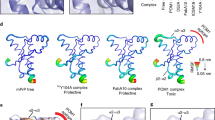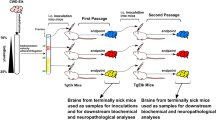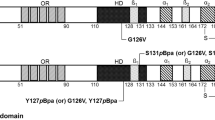Abstract
In animals infected with a transmissible spongiform encephalopathy, or prion disease, conformational isomers (known as PrPSc proteins) of the wild-type, host-encoded cellular prion protein (PrPC) accumulate. The infectious agents, prions, are composed mainly of these conformational isomers, with distinct prion isolates or strains being associated with different PrPSc conformations and patterns of glycosylation. Here we show that two different human PrPSc types, seen in clinically distinct subtypes of classical Creutzfeldt–Jakob disease, can be interconverted in vitro by altering their metal-ion occupancy. The dependence of PrPSc conformation on the binding of copper and zinc represents a new mechanism for post-translational modification of PrP and for the generation of multiple prion strains, with widespread implications for both the molecular classification and the pathogenesis of prion diseases in humans and animals.
This is a preview of subscription content, access via your institution
Access options
Subscribe to this journal
Receive 12 print issues and online access
$209.00 per year
only $17.42 per issue
Buy this article
- Purchase on Springer Link
- Instant access to full article PDF
Prices may be subject to local taxes which are calculated during checkout




Similar content being viewed by others
References
Will, R. G. et al. A new variant of Creutzfeldt-Jakob disease in the UK. Lancet 347, 921–925 ( 1996).
Collinge, J., Sidle, K. C. L., Meads, J., Ironside, J. & Hill, A. F. Molecular analysis of prion strain variation and the aetiology of ‘new variant’ CJD. Nature 383, 685–690 ( 1996).
Bruce, M. E. et al. Transmissions to mice indicate that ‘new variant’ CJD is caused by the BSE agent. Nature 389, 498–501 (1997).
Hill, A. F. et al. The same prion strain causes vCJD and BSE. Nature 389, 448–450 ( 1997).
Prusiner, S. B. Molecular biology of prion diseases. Science 252, 1515–1522 (1991).
Pan, K.-M. et al. Conversion of α-helices into β-sheets features in the formation of the scrapie prion proteins. Proc. Natl Acad. Sci. USA 90, 10962–10966 ( 1993).
Riek, R. et al. NMR structure of the mouse prion protein domain PrP (121–231) . Nature 382, 180–182 (1996).
Bessen, R. A. & Marsh, R. F. Distinct PrP properties suggest the molecular basis of strain variation in transmissible mink encephalopathy . J. Virol. 68, 7859–7868 (1994).
Bessen, R. A. et al. Non-genetic propagation of strain-specific properties of scrapie prion protein. Nature 375, 698– 700 (1995).
Telling, G. C. et al. Evidence for the conformation of the pathologic isoform of the prion protein in enciphering and propagating prion diversity. Science 274, 2079–2082 ( 1996).
Caughey, B., Raymond, G. J. & Bessen, R. A. Strain-dependent differences in β-sheet conformations of abnormal prion protein. J. Biol. Chem. 273, 32230–32235 (1998).
Collinge, J. Human prion diseases and bovine spongiform encephalopathy (BSE). Hum. Mol. Genet. 6, 1699–1705 (1997).
Collinge, J., Palmer, M. S. & Dryden, A. J. Genetic predisposition to iatrogenic Creutzfeldt–Jakob disease. Lancet 337, 1441– 1442 (1991).
Palmer, M. S., Dryden, A. J., Hughes, J. T. & Collinge, J. Homozygous prion protein genotype predisposes to sporadic Creutzfeldt-Jakob disease. Nature 352, 340– 342 (1991).
Collinge, J., Beck, J., Campbell, T., Estibeiro, K. & Will, R. G. Prion protein gene analysis in new variant cases of Creutzfeldt–Jakob disease. Lancet 348, 56 (1996).
Hill, A. F. et al. Investigation of variant Creutzfeldt–Jakob disease and other human prion diseases with tonsil biopsy samples. Lancet 353, 183–189 (1999).
Parchi, P. et al. Molecular basis of phenotypic variability in sporadic Creutzfeldt–Jakob disease. Ann. Neurol. 39, 767– 778 (1996).
Parchi, P. et al. Typing prion isoforms. Nature 386, 232–233 (1997).
Hornshaw, M. P., McDermott, J. R. & Candy, J. M. Copper binding to the N-terminal tandem repeat regions of mammalian and avian prion protein. Biochem. Biophys. Res. Commun. 207, 621–629 ( 1995).
Hornshaw, M. P., McDermott, J. R., Candy, J. M. & Lakey, J. H. Copper binding to the N-terminal tandem repeat region of mammalian and avian prion protein: structural studies using synthetic peptides. Biochem. Biophys. Res. Commun. 214, 993–999 (1995).
Miura, T., Hori-i, A. & Takeuchi, H. Metal-dependent a-helix formation promoted by the glycine-rich octapeptide region of prion protein. FEBS Lett. 396 , 248–252 (1996).
Brown, D. R. et al. The cellular prion protein binds copper in vivo. Nature 390, 684–687 ( 1997).
Stöckel, J., Safar, J., Wallace, A. C., Cohen, F. E. & Prusiner, S. B. Prion protein selectively binds copper(II) ions. Biochemistry 37, 7185–7193 (1998).
Viles, J. H. et al. Copper binding to the prion protein: structural implications of four identical cooperative binding sites. Proc. Natl Acad. Sci. USA 96, 2042–2047 ( 1999).
Atwood, C. S. et al. Dramatic aggregation of Alzheimer Aβ by Cu(II) is induced by conditions representing physiological acidosis. J. Biol. Chem. 273, 12817–12826 ( 1998).
Assaf, S. Y. & Chung, S.-H. Release of endogenous Zn2+ from brain tissue during activity. Nature 308, 734–736 (1984).
Lovell, M. A. et al. Copper, iron and zinc in Alzheimer’s disease senile plaques. J. Neurol. Sci. 158, 47– 52 (1998).
Collins, S. et al. Surgical treatment and risk of sporadic Creutzfeldt-Jakob disease: a case-control study. Lancet 353, 693–697 (1999).
McKenzie, D. et al. Reversibility of scrapie inactivation is enhanced by copper . J. Biol. Chem. 273, 25545– 25547 (1998).
Carlton, W. W. Spongiform encephalopathy induced in rats and guinea pigs by cuprizone. Exp. Mol. Pathol. 10, 274–287 (1969).
Pattison, I. H. & Jebbett, J. N. Histopathological similarities between scrapie and cuprizone toxicity in mice. Nature 230, 115–117 ( 1971).
Pauly, P. C. & Harris, D. A. Copper stimulates endocytosis of the prion protein. J. Biol. Chem. 273, 33107–33110 (1998).
Dawson, R. M. C., Elliott, D. C., Elliott, W. H. & Jones, K. M. Data for Biochemical Research 3rd edn 399–415 (Clarendon, Oxford, 1986).
Acknowledgements
This work was funded by the Medical Research Council and Wellcome Trust. We thank R. Will, J. Ironside and colleagues at the National CJD Surveillance Unit for help with this study.
Correspondence and requests for materials should be addressed to J. C.
Author information
Authors and Affiliations
Corresponding author
Rights and permissions
About this article
Cite this article
Wadsworth, J., Hill, A., Joiner, S. et al. Strain-specific prion-protein conformation determined by metal ions. Nat Cell Biol 1, 55–59 (1999). https://doi.org/10.1038/9030
Received:
Revised:
Accepted:
Issue Date:
DOI: https://doi.org/10.1038/9030
This article is cited by
-
Real-time tracking of ionic nano-domains under shear flow
Scientific Reports (2021)
-
The Three Glycotypes in the London Classification System of Sporadic Creutzfeldt-Jakob Disease Differ in Disease Duration
Molecular Neurobiology (2021)
-
Molecular pathology of human prion disease
Acta Neuropathologica (2011)



